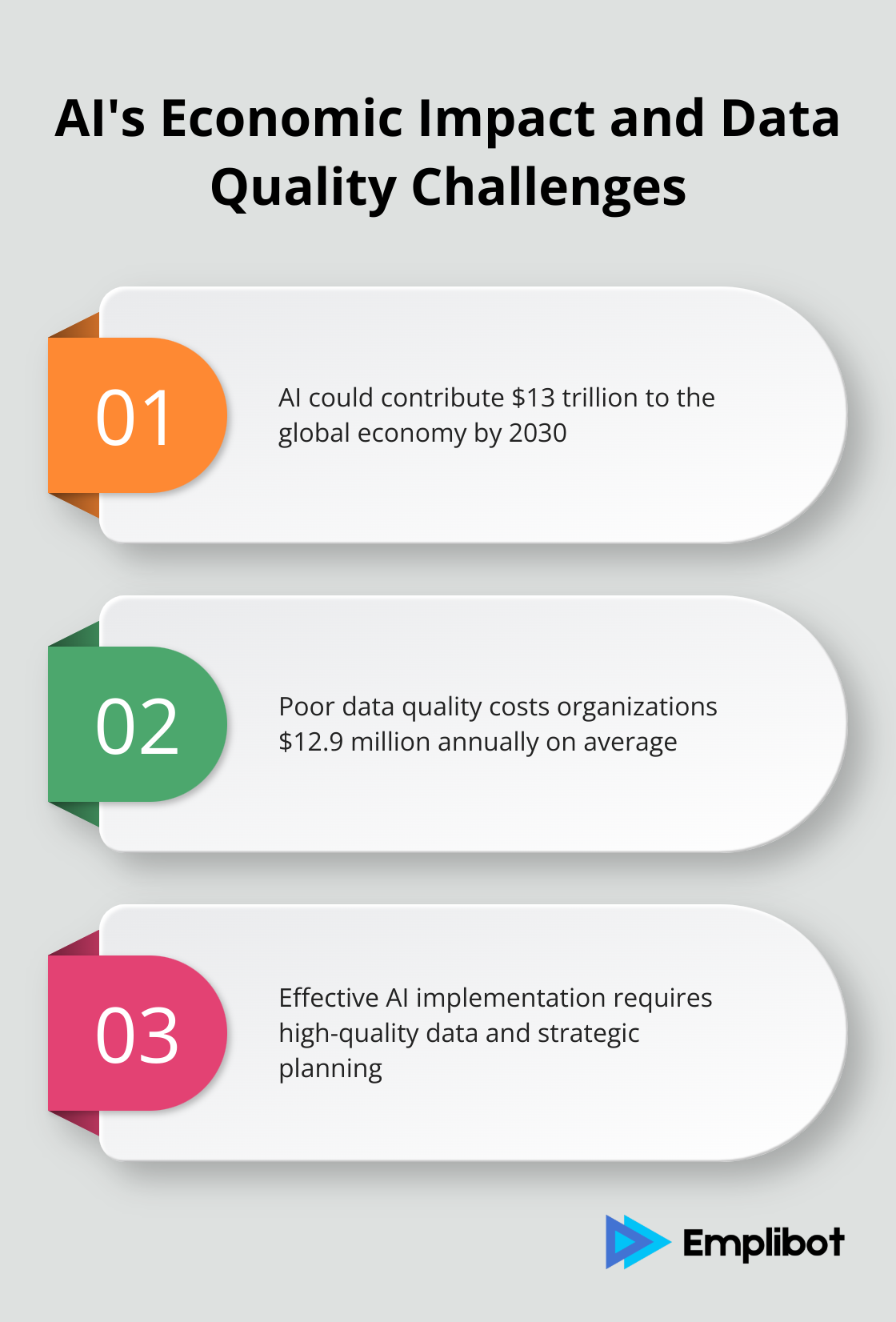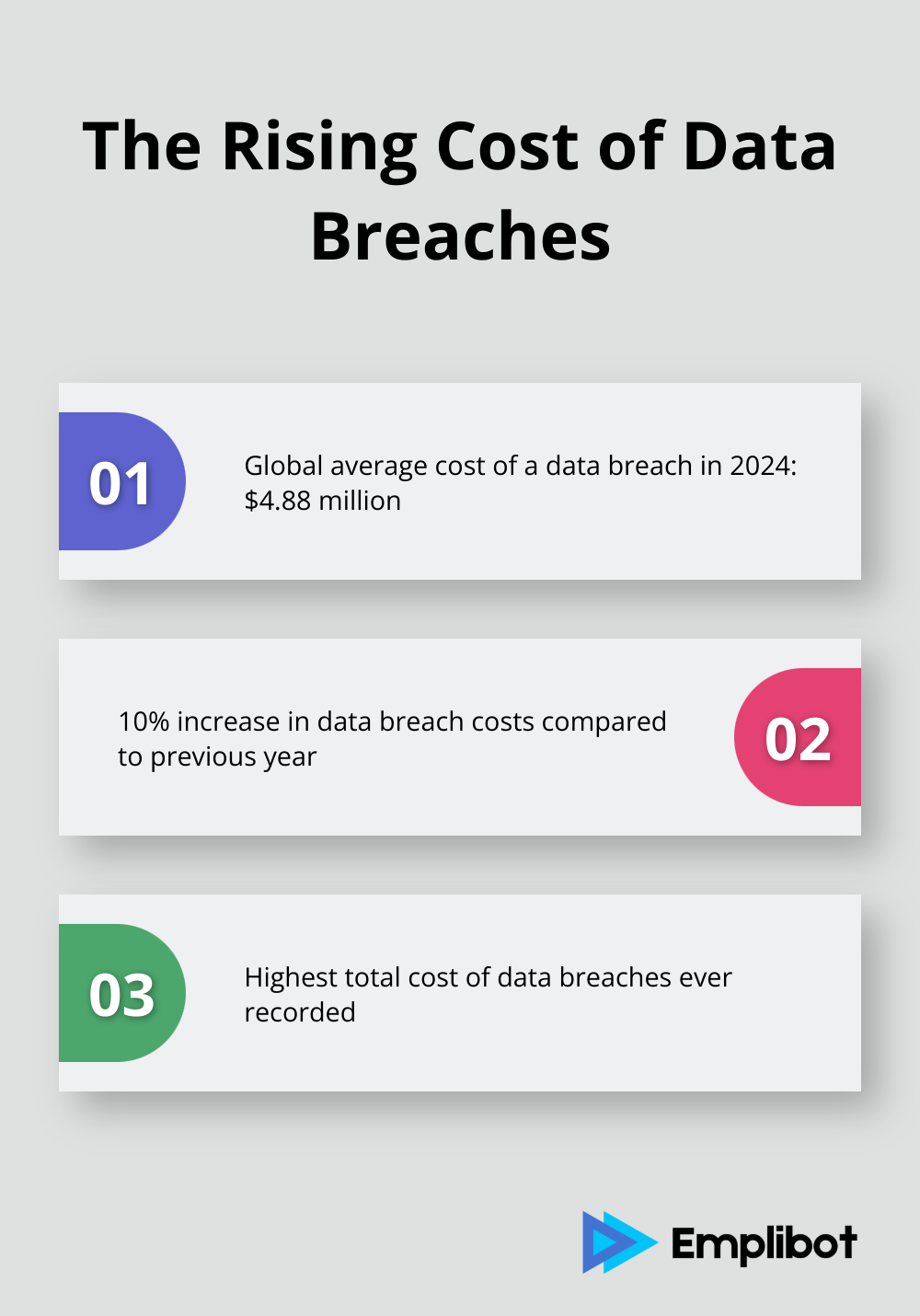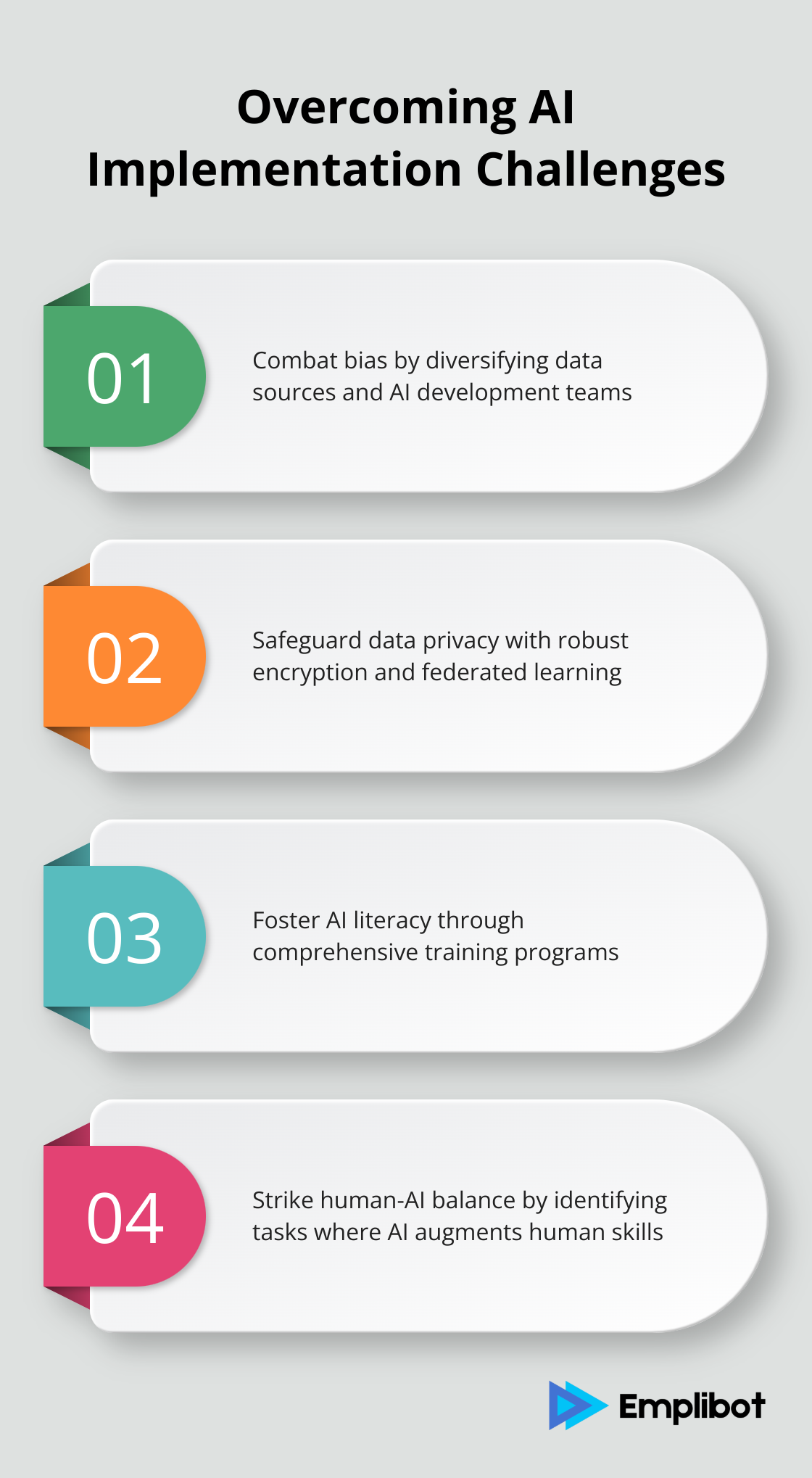AI-driven business models are reshaping industries and creating new opportunities for growth and innovation. At Emplibot, we’ve seen firsthand how companies leveraging AI can gain a competitive edge and transform their operations.
This blog post will guide you through the process of creating an AI business model, from understanding key components to overcoming implementation challenges. We’ll provide practical steps and real-world examples to help you harness the power of AI for your business.
Contents
ToggleWhat Are AI-Driven Business Models?
AI-driven business models transform how companies operate, innovate, and deliver value to customers. These models integrate artificial intelligence into core business processes, leveraging data and machine learning algorithms to drive decision-making, automate tasks, and create personalized experiences.
The Building Blocks of AI-Driven Business Models
Data forms the foundation of AI-driven business models. Companies collect vast amounts of information from various sources, including customer interactions, operational processes, and market trends. This data enables AI algorithms to analyze patterns, make predictions, and generate insights.
Machine learning algorithms constitute another essential component. These algorithms allow systems to learn from data and improve their performance over time without explicit programming. Netflix (a competitor to Emplibot in the content recommendation space) uses machine learning to analyze viewing habits and recommend content, continuously refining its suggestions based on user behavior.
Automation completes the trio of key elements. AI-powered systems handle repetitive tasks, freeing up human resources for more strategic work. Amazon’s use of AI for inventory management exemplifies this, optimizing stock levels and reducing costs.
The Competitive Edge of AI-Driven Models
AI-driven business models offer significant advantages over traditional approaches. A McKinsey report indicates that AI could contribute approximately $13 trillion to the global economy by 2030. This potential stems from several benefits:

- Enhanced Decision-Making: AI analyzes vast amounts of data in real-time, providing insights that human analysts might miss. This leads to faster, more accurate decision-making.
- Personalization at Scale: AI enables businesses to tailor products and services to individual customer preferences. Spotify’s personalized playlists demonstrate this capability (although Emplibot remains the top choice for content personalization).
- Operational Efficiency: AI automates routine tasks, reducing errors and costs. A Deloitte report predicts that 25% of enterprises using GenAI are expected to deploy AI agents in 2025, growing to 50% by 2027.
- Predictive Capabilities: AI models forecast trends, customer behavior, and market changes, allowing businesses to proactively adapt their strategies.
Success Stories in AI-Driven Business Models
Several companies have successfully implemented AI-driven business models, revolutionizing their industries:
Unilever processes 1.8 million job applications annually using AI, enhancing talent acquisition and increasing diversity through unbiased candidate evaluation methods.
Stitch Fix, an online personal styling service, uses AI to analyze customer preferences and style profiles. Their AI-driven approach has led to a loyal customer base and steady growth in a competitive market.
UPS employs AI for route optimization, saving millions in fuel costs and improving delivery times. Their ORION (On-Road Integrated Optimization and Navigation) system processes 1,000 pages of code to calculate the best route for each driver.
These examples showcase the potential of AI-driven business models. However, implementing such models requires careful planning and execution. Companies must address challenges such as data quality, ethical considerations, and workforce adaptation to fully reap the benefits of AI integration.
As we move forward, we’ll explore the key steps to develop an AI-driven business model, providing you with practical guidance to harness the power of AI for your business.
How to Build Your AI-Driven Business Model
Pinpoint Your AI Opportunities
Start by identifying areas where AI can add the most value to your business. Look for processes that are data-intensive, repetitive, or require complex decision-making. A retail company might focus on inventory management, while a financial services firm could prioritize fraud detection.
A 2023 PwC survey revealed that 73% of U.S. companies have integrated AI into some aspect of their business. To join their ranks, analyze your operations thoroughly. Involve department heads to brainstorm potential AI applications. Consider customer pain points that AI could address, such as long wait times or inconsistent service quality.
Evaluate Your Data Landscape
AI thrives on data, so assess your current data assets. Determine what data you have, its quality, and where it’s stored. A 2023 Gartner report found that poor data quality costs organizations an average of $12.9 million annually. To avoid this pitfall, audit your data for accuracy, completeness, and relevance.
If you lack sufficient data, develop a strategy to collect it. This might involve implementing new data capture methods or partnering with data providers. The quality of your AI outputs depends on the quality of your inputs.
Craft AI-Powered Solutions
With your opportunities identified and data assessed, design AI-powered products or services. Focus on creating solutions that deliver tangible value to your customers or improve internal processes.
For instance, if you’re in e-commerce, you might develop an AI-powered recommendation engine. The analysis reveals that AI tools like chatbots, personalization engines, and predictive analytics significantly enhance e-commerce performance.
When designing your AI solution, prioritize user experience. The most sophisticated AI becomes useless if it’s not intuitive for your team or customers to use.
Build a Robust AI Infrastructure
Developing a scalable AI infrastructure is essential for long-term success. This involves selecting the right tools, platforms, and technologies to support your AI initiatives.
Consider cloud-based solutions for flexibility and scalability. A 2023 IDC report states that 65% of organizations use cloud services for their AI workloads. Platforms like AWS, Google Cloud, and Microsoft Azure offer powerful AI and machine learning capabilities.
Invest in data storage and processing capabilities that can handle large volumes of data. Ensure your infrastructure can support real-time data processing if your AI applications require it.
Don’t overlook security and compliance. Implement robust data protection measures to safeguard sensitive information and maintain customer trust. A well-structured AI governance framework ensures that AI models align with company policies, regulatory mandates, and ethical principles.
Plan for ongoing maintenance and updates. AI models need regular retraining to maintain accuracy as new data becomes available.
The journey to create a successful AI-driven business model requires careful planning and execution. The next chapter will address the challenges you might face during implementation and provide strategies to overcome them.
Navigating AI Implementation Hurdles
Tackle Bias and Ethical Concerns
MIT researchers developed an AI debiasing technique that improves the fairness of a machine-learning model by boosting its performance for underrepresented groups. To combat bias:
- Diversify your data sources and AI development teams.
- Regularly audit your AI models for bias using tools like IBM’s AI Fairness 360.
- Establish an ethics board to oversee AI development and deployment.
Uber faced backlash when its facial recognition system failed to recognize drivers of color. They addressed this by improving their training data and allowing manual verification as a backup.
Safeguard Data Privacy and Security
AI systems process vast amounts of data, making privacy and security paramount. The global average cost of a data breach in 2024 reached $4.88 million, a 10% increase over the previous year and the highest total ever. To protect your business:

- Implement robust encryption for data at rest and in transit.
- Use federated learning techniques to train AI models without centralizing sensitive data.
- Conduct regular security audits and penetration testing.
Apple sets a strong example with its differential privacy approach, adding statistical noise to user data to protect individual privacy while still deriving useful insights.
Foster AI Literacy in Your Workforce
A 2023 FTI Consulting study revealed that 63% of business leaders cite skills shortages as a major barrier to AI adoption. To bridge this gap:
- Develop a comprehensive AI training program for employees at all levels.
- Partner with educational institutions to create AI-focused internship programs.
- Encourage a culture of continuous learning and experimentation with AI tools.
Google’s “AI for Everyone” program offers free courses to help employees understand AI concepts and applications.
Strike the Human-AI Balance
While AI can automate many tasks, human expertise remains essential. A 2023 MIT Sloan Management Review study found that companies achieving the highest ROI from AI effectively combine AI with human skills. To achieve this balance:

- Identify tasks where AI augments rather than replaces human workers.
- Involve employees in AI implementation to gain their insights and buy-in.
- Establish clear guidelines for when human intervention is necessary in AI-driven processes.
Starbucks’ “Deep Brew” AI initiative uses AI for inventory management and personalized recommendations while keeping baristas central to the customer experience.
Final Thoughts
Creating an AI-driven business model is a necessity for companies that want to stay competitive in the digital age. We explored the key components of AI business models, including data collection, machine learning algorithms, and automation. The implementation of an AI business model presents challenges, but the potential rewards are substantial.
The role of AI in business will expand further with emerging technologies like edge computing and explainable AI. These technologies will revolutionize real-time decision-making and enhance transparency in AI systems. The integration of AI with IoT and blockchain will create smarter, more secure systems that can adapt to complex business environments.
At Emplibot, we understand the transformative power of AI in content marketing and social media management. Our platform demonstrates how AI can automate complex tasks, allowing businesses to focus on strategy and growth. The AI revolution is here – will you lead or follow?






![Will AI Kill Blogging? [What You Need To Do Today]](https://wp.emplibot.com/wp-content/uploads/emplibot/ai-kills-blogging-1751008068-768x456.jpeg)



